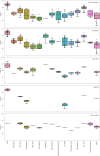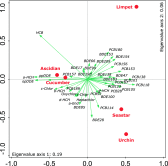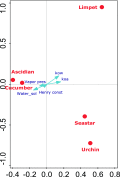Legacy and Emerging Persistent Organic Pollutants in Antarctic Benthic Invertebrates near Rothera Point, Western Antarctic Peninsula
- PMID: 31950826
- PMCID: PMC7057541
- DOI: 10.1021/acs.est.9b06622
Legacy and Emerging Persistent Organic Pollutants in Antarctic Benthic Invertebrates near Rothera Point, Western Antarctic Peninsula
Erratum in
-
Correction to Legacy and Emerging Persistent Organic Pollutants in Antarctic Benthic Invertebrates near Rothera Point, Western Antarctic Peninsula.Environ Sci Technol. 2020 Jun 2;54(11):7023. doi: 10.1021/acs.est.0c01724. Epub 2020 May 20. Environ Sci Technol. 2020. PMID: 32432854 Free PMC article. No abstract available.
Abstract
Pollutant levels in polar regions are gaining progressively more attention from the scientific community. This is especially so for pollutants that persist in the environment and can reach polar latitudes via a wide range of routes, such as some persistent organic pollutants (POPs). In this study, samples of Antarctic marine benthic organisms were analyzed for legacy and emerging POPs (polychlorinated biphenyls (PCBs), polybrominated diphenyl ethers (PBDEs), and organochlorine pesticides) to comprehensively assess their current POP concentrations and infer the potential sources of the pollutants. Specimens of five benthic invertebrate species were collected at two distinct locations near Rothera research station on the Antarctic Peninsula (67°35'8 ̋ S and 68°7'59 ̋ W). Any impact of the nearby Rothera station as a local source of pollution appeared to be negligible. The most abundant chemicals detected were hexachlorobenzene (HCB) and BDE-209. The highest concentrations detected were in limpets and sea urchins, followed by sea stars, ascidians, and sea cucumbers. The relative congener patterns of PCBs and PBDEs were similar in all of the species. Some chemicals (e.g., heptachlor, oxychlordane, and mirex) were detected in the Antarctic invertebrates for the first time. Statistical analyses revealed that the distribution of the POPs was not only driven by the feeding traits of the species but also by the physicochemical properties of the specific compounds.
Conflict of interest statement
The authors declare no competing financial interest.
Figures






References
-
- Andreas B.; Donald M.; Michael M.; Frank W.; Webster E. Assessing long-range transport potential of persistent organic pollutants. Environ. Sci. Technol. 2000, 34, 699–703. 10.1021/es990207w. - DOI
Publication types
MeSH terms
Substances
LinkOut - more resources
Full Text Sources
Miscellaneous

